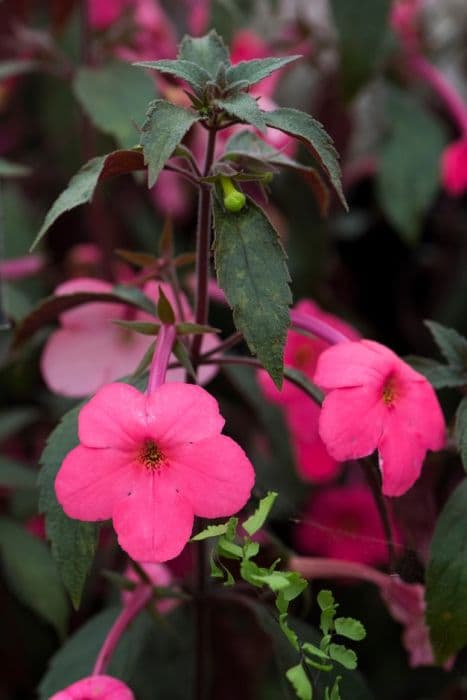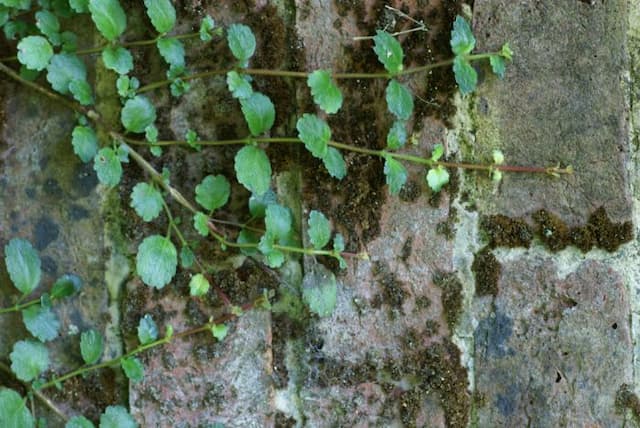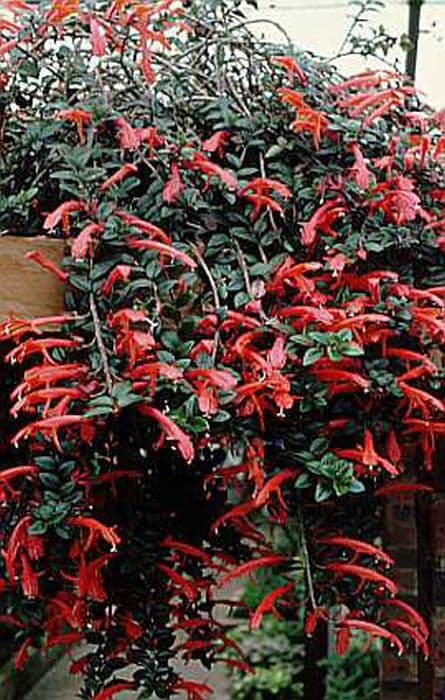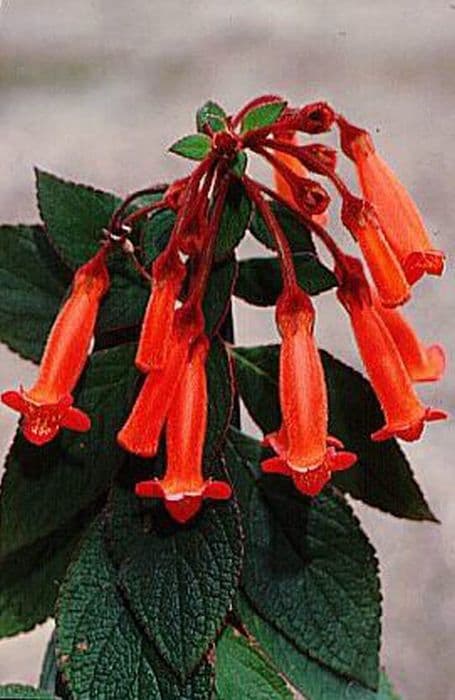Pyrenean Violet Ramonda myconi

ABOUT
Ramonda myconi, commonly known as Pyrenean violet, is a remarkable plant that exhibits a rosette of leaves at its base. The leaves are dark green and often have a slightly hairy texture which can give them a felt-like feel to the touch. The shape of the leaves is broadly oval, sometimes with a heart-like base, and they can show a crinkled or scalloped edge, adding to their decorative appearance. From the center of this basal rosette, emerge delicate flowers that are borne on individual stems. These blossoms display a soft purple or violet hue, with a lighter or even white center, producing a striking contrast. The petals of these flowers are arranged in a trumpet shape, typical of many flowers in related families, inviting pollinators with their bright colors and accessible form. Pyrenean violet's growth habit and leaf arrangement allow it to thrive in the rocky crevices and nooks where it is often found. Its ability to exist in such environments is complemented by a robust yet petite structure that gives it a distinctive, hardy character without sacrificing its delicate floral beauty.
About this plant
 Names
NamesFamily
Gesneriaceae.
Synonyms
Pyrenean Violet, Rosette Mullein.
Common names
Ramonda myconi subsp. myconi, Ramonda pyrenaica, Ramondia pyrenaica.
 Toxicity
ToxicityTo humans
Ramonda myconi, commonly known as Pyrenean violet, is not known to be toxic to humans. There are no well-documented symptoms of poisoning because it is not considered a poisonous plant. Therefore, accidental ingestion of the Pyrenean violet is unlikely to have toxic consequences.
To pets
Pyrenean violet is also not known to be toxic to pets. As with humans, there is no documented toxicity or symptoms of poisoning associated with pets ingesting any part of the Pyrenean violet. Thus, consumption of this plant by pets is not expected to result in significant health issues.
 Characteristics
CharacteristicsLife cycle
Perennials
Foliage type
Evergreen
Color of leaves
Green
Flower color
Purple
Height
0.33 feet (10 cm)
Spread
0.5 feet (15 cm)
Plant type
Herb
Hardiness zones
6
Native area
Europe
Benefits
 General Benefits
General Benefits- Aesthetic value: Ramonda myconi, commonly known as Pyrenean violet, adds visual interest to rock gardens and alpine collections with its rosettes of dark green leaves and beautiful purple flowers.
- Drought tolerance: Being a resurrection plant, Pyrenean violet can survive long periods of drought by curling its leaves and going dormant until sufficient moisture is available again.
- Cold resistance: Native to mountainous regions, this plant is well-adapted to cold temperatures, making it suitable for gardens in cooler climates.
- Low maintenance: Pyrenean violet requires minimal upkeep, thriving in poor soils and without the need for regular watering or fertilization.
- Wildlife support: The flowers of Pyrenean violet provide a source of nectar for pollinators like bees and butterflies, supporting biodiversity.
- Soil erosion control: The low-growing, mat-forming nature of Pyrenean violet helps stabilize soil, especially on slopes and in rock gardens, preventing erosion.
- Educational interest: Due to its unique ability to survive desiccation, Pyrenean violet can be used in educational settings to demonstrate plant adaptation and survival strategies.
- Heritage and conservation: As a plant endemic to the Pyrenees, Pyrenean violet represents the botanical heritage of its native region and plays a role in biodiversity conservation efforts.
 Medical Properties
Medical Properties- This plant is not used for medical purposes
 Air-purifying Qualities
Air-purifying QualitiesThis plant is not specifically known for air purifying qualities.
 Other Uses
Other Uses- Symbolism: Ramonda myconi, also known as Pyrenean violet, is often used to symbolize remembrance or a part of historical national emblems due to its resilience and ability to survive in harsh conditions.
- Educational Tool: The plant is used by educators to demonstrate desiccation tolerance in plants, showing how it can recover from a completely dried state when rehydrated.
- Botanical Art: Pyrenean violet's unique appearance makes it a subject of interest for botanical artists and illustrators, capturing its beauty in various forms of art.
- Biodiversity Indicator: It can serve as an indicator species in its native habitat, meaning its presence can signify a well-preserved ecosystem and is often used in conservation studies.
- Natural Dye: The plant has the potential to be used as a source of natural dye for textiles, though it's not a common practice given its rarity and conservation status.
- Specialized Gardening: Ramonda myconi is used in alpine and rock gardens, appreciated by specialist gardeners for its ability to grow in crevices and rocky substrates with little soil.
- Photography: The unique survival capabilities and aesthetic of the Pyrenean violet make it a captivating subject for nature photographers, especially macro photography enthusiasts.
- Horticultural Research: The Pyrenean violet is studied in horticulture for its unusual drought resistance mechanisms, providing insight for developing more resilient garden plant varieties.
- Ecotourism Attraction: Areas where Ramonda myconi grows naturally can become points of ecotourism, attracting visitors interested in the unique flora of the Pyrenees mountain range.
- Astronaut Training: Due to its ability to withstand extreme conditions, Ramonda myconi could potentially be studied for astronaut training programs that simulate survival in adverse environments.
Interesting Facts
 Feng Shui
Feng ShuiThe Pyrenean Violet is not used in Feng Shui practice.
 Zodiac Sign Compitability
Zodiac Sign CompitabilityThe Pyrenean Violet is not used in astrology practice.
 Plant Symbolism
Plant Symbolism- Resilience: Ramonda myconi, also known as Pyrenean-violet, is a symbol of resilience due to its ability to survive in harsh mountainous environments, often in rocky crevices with little soil.
- Survival: The Pyrenean-violet exhibits a remarkable survival technique called poikilohydry, which allows it to withstand extreme desiccation and then recover when conditions improve, making it a symbol of endurance and adaptability.
- Rare Beauty: Being a rare and protected species in some regions, the Pyrenean-violet represents unique and delicate beauty that is to be treasured and preserved.
- Rebirth: As a plant that can return to life after appearing dead due to drought, the Pyrenean-violet signifies rebirth and new beginnings.
- Hope: The Pyrenean-violet's ability to bloom in challenging conditions makes it a symbol of hope and encouragement in finding beauty in adversity.
 Water
WaterThe Pyrenean Violet needs moderate watering, allowing the soil to dry slightly between waterings. Water this plant thoroughly, giving it about 8-10 ounces every week during the active growing season, which is spring and summer. In the fall and winter, reduce watering to every other week, ensuring not to over-saturate the soil as this plant is sensitive to overwatering.
 Light
LightThe Pyrenean Violet prefers partial shade to filtered sunlight. It thrives best in bright, indirect light, so a spot near a north or east-facing window would be ideal. Avoid placing it in direct sunlight, especially during the summer months, to prevent leaf scorch.
 Temperature
TemperatureThe Pyrenean Violet is comfortable in temperatures between 50°F and 77°F. It can survive minimal exposure to temperatures as low as 28°F but should not be subjected to freezing conditions for prolonged periods. Ideally, keep the Pyrenean Violet in an environment that is consistently above 50°F.
 Pruning
PruningThe Pyrenean Violet benefits from occasional pruning to remove dead or yellowing leaves, which promotes healthy growth and improves air circulation. Prune sparingly, as needed, rather than on a strict schedule. The best time for pruning is in the spring, just before the new growing season begins.
 Cleaning
CleaningAs needed
 Soil
SoilPyrenean Violet, or Ramonda myconi, thrives in well-draining soil with a mix of leaf mold, peat, and loam in equal parts. The soil pH should be slightly acidic to neutral, ranging from 5.5 to 7.0.
 Repotting
RepottingPyrenean Violet is not frequently repotted; it should be repotted every 3 to 4 years or when it outgrows its current container.
 Humidity & Misting
Humidity & MistingPyrenean Violet prefers high humidity, ideally between 75-85%, simulating its natural humid mountain habitats.
 Suitable locations
Suitable locationsIndoor
Keep Pyrenean Violet in bright, indirect light with high humidity.
Outdoor
Place Pyrenean Violet in partial shade with shelter from wind.
Hardiness zone
6-8 USDA
 Life cycle
Life cycleRamonda myconi, commonly known as Pyrenean-violet, begins its lifecycle as a spore, being a member of the Gesneriaceae family, not producing seeds for reproduction like many flowering plants. When the right conditions of moisture and temperature are met, the spores germinate into tiny gametophytes, which are haploid and produce gametes. Fertilization occurs when sperm reaches the eggs, leading to the formation of a diploid zygote. The zygote then develops into a sporophyte, the recognizable form of Pyrenean-violet, which is the dominant stage of its life cycle. The mature sporophyte produces flowers, typically with pink or violet petals, which upon successful pollination, develop into capsules containing spores, thus completing the cycle. Throughout its perennial life, the plant experiences seasonal dormancy, re-emerging in the spring to continue its growth and reproduction cycle.
 Propogation
PropogationPropogation time
Spring-early summer
Propogation: Ramonda myconi, commonly known as Pyrenean-violet, is often propagated by seed, and the best time to sow seeds is in spring. To propagate Pyrenean-violet by seed, first, collect the seeds from the plant after the flowers have faded and the seed pods have dried. Fill a tray with a well-draining seed starting mix and sprinkle the seeds thinly on the surface. Press them gently into the soil without covering them, as they need light to germinate. Keep the soil moist but not waterlogged, and maintain a temperature of around 68°F (20°C). Germination can take several weeks, so be patient. Once the seedlings have developed a few true leaves and are large enough to handle, you can transplant them into individual pots or out into the garden.









